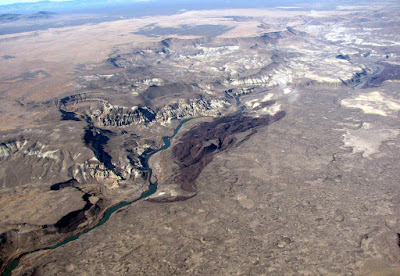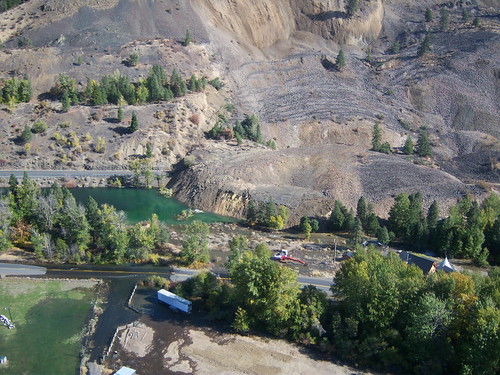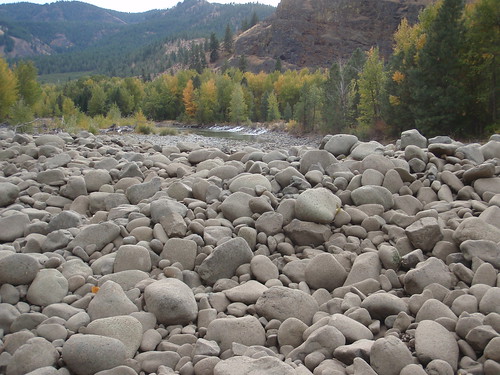Ok. So Google is apparently never going to upload the high-res NAIP
imagery of the Owyhee River study area. Here is a work-around. Draping
the LiDAR on the bad imagery. Looks pretty damn good. Now we are very
proficient at doing this. On our way to developing some more elaborate
geologic projects in Google Earth. Should probably start with adding the hi-res imagery ourselves....
Wednesday, December 9, 2009
Owyhee River LiDAR drape on low-res Google Earth images
Sunday, November 22, 2009
Friday, November 13, 2009
New and Improved Profile figure and other...
Lyell was a closeted catastrophist?
which follows upon...
Who is our extrafluvial catastrophist? None other than Charles Lyell!Lyell, C., 1830, The Principles of Geology, vol. i. John Murray, London.
The first quote is from page 192, and refers directly to floods resulting from breached obstructions as key to forming valleys. The second quote is from page 188.
Thursday, November 12, 2009
Thursday, November 5, 2009
Short clip of the Owyhee fly-over...
Worth a look. Gives a good impression of what the flight was like. Certainly quicker than a raft.
Wednesday, November 4, 2009
Slide Show from Today's Owyhee Fly-over
http://picasaweb.google.com/drjerque/OwyheeFlyOver?feat=directlink
Once there, choose view on map, or grab the kml link for a better overall experience. Note however, that the geotagging is locally off...I wasn't totally prepared to deal with a tracklog derived from a trip in a vehicle that was usually moving more than 150 mph or so. In that case, the clocks need to be tightly calibrated (to the second) and the track precision needs to be high. I will manually fix the egregious ones using the new and nifty interactive geotagging interface in Picasa.
An amazing day in the field...



Tuesday, November 3, 2009
Will be visiting the field area tomorrow...in a plane!
Tomorrow I get a chance to fly over the field area in a small plane
fitted with an underwing camera. This was part of the deal that got me
to agree to teach field camp this last summer...and it is finally
coming through. Greg Arehart, my UNR colleague, has offered to fly me
over the area and snap many, many photos with his spiffy camera. These
will be ideal for creating large scale stereopairs of key areas
(failed blockages, landslide dams, etc) and also many great oblique
shots.
Flash Earth and Geohacks...Who knew? Not me.
Just happened upon a sweet and simple geobrowser called Flash Earth...very smooth and easy to understand. Added bonus for me is that it links to high-res images of my favorite field area that are available only in Yahoo and Bing Maps:
Wednesday, October 28, 2009
SR 410 Nile Valley Landslide (west of Naches)

SR 410 Nile Valley Landslide (west of Naches), originally uploaded by Washington State Dept of Transportation.
An excellent view of the landslide...nicely done.
SR 410 Nile Valley Landslide (west of Naches)

SR 410 Nile Valley Landslide (west of Naches), originally uploaded by Washington State Dept of Transportation.
Check out the great photoset of the recent landslide near Naches, Washington.
http://www.flickr.com/photos/wsdot/sets/72157622438776353/
Saturday, October 24, 2009
Impressive lava-river interaction in Argentina
GEOMORPHIC HISTORY OF RIVERS DRAINING THE EASTERN ANDEAN CORDILLERA (34–37°S) CONSTRAINED BY TEPHROCHRONOLOGY, U-SERIES DATING OF PEDOGENIC CARBONATE AND COSMOGENIC 3HE DATING OF BASALT FLOWS
HYNEK, Scott A., Geology and Geophysics, University of Utah, 115 S 1460 E, Salt Lake City, UT 84112-0119, scott.hynek@utah.edu, MARCHETTI, David W., Geology Program, Western State College of Colorado, 600 N. Adams St, Gunnison, CO 81231, FERNANDEZ, Diego P., Geology and Geophysics, University of Utah, 115 S. 1460 E. Rm 383, Salt Lake City, UT 84112, and CERLING, Thure E., Department of Geology and Geophysics, University of Utah, Salt Lake City, UT 84112Alluvial deposits and associated geomorphic features are dated by their relation with volcanic rocks. The age range and geologic setting requires a broad approach to constraining the history of rivers draining the Cordillera. Maximum age estimates are provided by identification of the ~ 450 ka Diamante Tuff in fill terraces. Along the Río Diamante this ash bed is observed >100 m above modern river level. In the Río Papagayos and Río Atuel drainages, the Diamante Tuff is associated with alluvial surfaces much closer to modern river level. Coarse Diamante pumice in the Río Atuel implies significant changes to the headwater drainage system since 450 ka. The maximum age constraint implied by occurrence of the Diamante Tuff in fill terraces has been successfully combined with minimum age estimates from cosmogenic 10Be approaching 350 ka (Baker et al., 2009). The relatively old age of alluvial surfaces in the region is additionally supported by U-series age estimates derived from pedogenic carbonate in volcanic soils. A minimum age in excess of 100 ka is conservative. The dated surface is underlain by a pumice/lapilli tephra deposit and basalt flows both of which have the potential to provide maximum age estimates for the surface. Conversely, the U-series data implies that the basaltic volcanism is older than 100 ka. Our age estimates of flows in several drainages are much younger. Cosmogenic 3He concentrations in hornblende from basaltic-andesites erupted along the Río Salado indicate exposure, and therefore eruption, ages younger than ~ 6 ka. These flows temporarily dammed the Río Salado in one location and bedrock incision below the level of the flows has occurred since. 3He concentrations in olivine from basaltic rocks at northeastern Volcán Payún Matru indicate a shield-building phase at ~ 40 ka. Recent basaltic aa flows from multiple vents are morphologically quite young and 3He exposure ages are forthcoming for one of them. The Río Grande has incised the older flows, and provides an average incision rate over a full glacial cycle. Combination of geochronological data from the region indicates provides accurate, if not tightly constrained, ages for alluvial surfaces and identifies spatially variable geomorphic rates influenced, in part, by contemporaneous volcanism.Lava v. River example from British Columbia

Kathy C. turned me on to this example yesterday. I had no idea. Lava flow is only about 250 yrs old. It is in the Stikine Volcanic Field. There is a related, somewhat brief, paper:
Thursday, October 22, 2009
Submerged tree in Clear Lake, Oregon
Wednesday, October 21, 2009
Friday, October 16, 2009
Owyhee lava and river profile figure...draft
Finally devised a way to confidently and easily extract profile data from the LiDAR data set in GlobalMapper. Surface profiles are simple. Basal profiles shown here are estimates based on some point measurements. Will vastly improve the basal profiles when GSA is over. Needed this figure, however, so spent too much time devising the method.
Wednesday, October 14, 2009
Nice renditions of the Owyhee River area map
Preparing for my GSA lava talk and came up with these new versions of
the map of the Owyhee River study area. The second one is just the lava.
The lava flow-landslide link laid bare

This one supports the tenet:
'Intracanyon lava flows, the gifts that keep on giving'.
A garishly colored map that underscores the tight linkage betweenlandslides and lava flows on the Owyhee. If it is not the margin of
the lava flow that is failing, then it is the canyon wall that the
lava flow forced the river against that is failing (or both).
Certainly a tight coupling in this reach, no?
Two pleasing renditions of the map
the map. The second one is just the lava.
Bogus Rim Lava / Iron Point Dam
Monday, October 12, 2009
West Crater and Saddle Butte lava faceoff at Ryegrass Creek
This upstream-looking 3-D block rendition of the Ryegrass Creek area on the Owyhee is intriguing. The color ramp works well here because the strata are flat-lying. Note the boulder-covered and very flat surface below the Qbsy and above Ryegrass Creek...I suspect it relates to the pre-Saddle Butte lava Owyhee or Ryegrass Ck channel in some way, but I have never actually stood on it. Also, look at the morphology of the eastern edge of the Qbsy where the lacustrine seds sit...distinct linear trace there was map as fault by Ferns et al., but isn't it just the contact between the paleovalley wall and the lava? What about that abrupt wall in the Qbsy flow just beyond there? Looks like it is heading down a narrow valley.
Thursday, October 8, 2009
Some intriguing LiDAR-based block models from the Owyhee
Thursday, October 1, 2009
State of the Owyhee Map: 10/01/09
2. Unit descriptions need to be written up using Cooper's thesis as a base. This part will require input from all principal members of the research team
3. Accompanying text to the map. This will be a detailed accounting of the geologic history implied / required by the geologic map.
4. Send the whole package out for review. Likely, we will do this through DOGAMI who have agreed to publish the map if we can cover most / all of the costs. Now, back to the lower Walker River map due in 15 days.


Wednesday, September 30, 2009
Geologic Map of the central Hole in the Ground area, Owyhee River, OR
Tuesday, September 29, 2009
Owyhee Mapping Project: All traverses by your pal, Kyle.
My 2009 field traverses in the Owyhee River study area
Yes. I am a little late on getting my NSF annual report done...why these are due 3 months before the end of the year in question is beyond me. Most annual reports are due within 3 months of the end of the contract year. I suspect that someone made a mistake in the original paperwork and simply won't own up to it.
LiDAR-derived contours are useful, too.

Sure, I have gone on and on about the amazing visualizations you can get with some tweaking of LiDAR data; however, it turns out that a pretty basic representation is also quite useful...contours. Yes, contours. Sometimes smaller scale features remain somewhat ambiguous in hillshades or slopeshades, but high-res, short interval contours from the LiDAR data can eliminate most of the ambiguity. In this case, it is a tiny area that I have struggled with on the Owyhee River. Here, a large landslide entered from the north, shoved the river channel to the south, and the river eventually worked its way back to the north to some extent. The array of surficial deposits in the void that comprises the right hand side of the image south of the river record this sequence of events as well as subsequent sedimentation by tributary fans. The contours really highlight the fans, and in conjunction with discernible drainage patterns evident in the LiDAR, it is clear what is fan and what is river, right?
Extent of lake caused by the Greeley Bar lava dam

I created this lake by generating a contour from the LiDAR dataset at an elevation of 1046 m. GlobalMapper does this in about 1.5 minutes. Then, exported the vector as a shapefile, cut out the parts of the line that occur downstream from the dam, stitch the remaining loose ends, build a poly from the line and there it is.





































